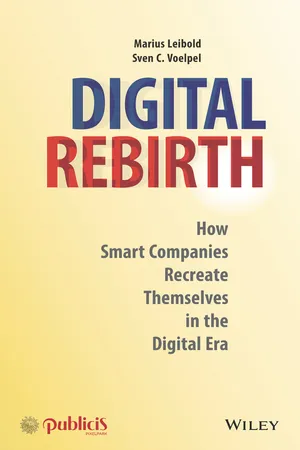
Digital Rebirth
How Smart Companies Recreate Themselves in the Digital Era
- English
- ePUB (mobile friendly)
- Available on iOS & Android
Digital Rebirth
How Smart Companies Recreate Themselves in the Digital Era
About this book
Digital Rebirth transcends digital transformation. It involves a revolutionary reinventing of the purpose, nature and processes of a company, with accompanying digital business and technological platforms.
This book presents a clear framework for practical digital rebirth of companies, contrasting it to prevalent "digital transformation" approaches. Aimed at large and medium-sized companies, as well as their subcontractors and service providers, but also at budding entrepreneurs, it should be read and used by company boards, executives, managers, startup leaders and business consultants..
- In every section of the book you will find proven concepts of Digital Rebirth, digital reinvention, collaborative digital practices, combinatorial technologies, digital platforms, digital ecosystems and pointers how to move from obsolete mindsets and left-over baggage to reinvented digitalization minds and processes.
- It shows clearly how some major companies have digitally rebirthed themselves - or are in the process of it - to be or to become a leading player in the digital economy.
- Company (and industry) illustrations are accompanied by descriptions of Digital Rebirth approaches, methodologies and practical tools.
- The book's content is ideal for use in company workshops and executive sessions, as well as business leadership mindset sessions, and has been validated in such activities by the authors, including boards of highly renowned companies on all continents.
- At the end of the book, the unique approach of Digital Rebirth is condensed into a framework of five digital drivers, to assist in the right activities for purposeful and successful company rebirth.
The concept of Digital Rebirth shows clearly that, in the light of recent developments like Internet of Things, Artificial Intelligence, Industry 4.0 and Cloud-based Services, well-established traditional industry and competitive models are not any longer satisfactory to understanding and dealing with digital realities.
Frequently asked questions
- Essential is ideal for learners and professionals who enjoy exploring a wide range of subjects. Access the Essential Library with 800,000+ trusted titles and best-sellers across business, personal growth, and the humanities. Includes unlimited reading time and Standard Read Aloud voice.
- Complete: Perfect for advanced learners and researchers needing full, unrestricted access. Unlock 1.4M+ books across hundreds of subjects, including academic and specialized titles. The Complete Plan also includes advanced features like Premium Read Aloud and Research Assistant.
Please note we cannot support devices running on iOS 13 and Android 7 or earlier. Learn more about using the app.
Information
Chapter 1
Introduction: The Why of Digital Rebirth
The Digital Era is Prompting a Fundamental Change in How a Company Creates, Captures and Delivers Value
- Digitalization causes new ways of ‘real-time’ connectivity of people and organizations, with new types of consumer value being created, captured and delivered. This is entirely different from the traditional value creation processes, with its value chain ‘control and ownership’ of resources, including R&D;
- Digitalization is currently viewed as mainly an ‘efficiency improvement’ challenge—in terms of greater speed, agility and real-time customer engagement—and as a ‘digitalizing our business model’ issue—not as a radical new way of thinking and doing business, i.e. Digital Rebirth, as necessitated by the digital-connectivity era.

- IoT-insurance-connected home, appliances, health industries, autos and buildings
- Systems of easy, agile engagement and feedback
- Enabling innovative insurance contracts and e-claims
- Artificial intelligence for 24/7 consumer experiences
- Cognitive insurance interfaces: AR, VR, Chatbots, insurance Big Data and smart analytics
- Consumer-insurance predictive behavior
- Innovative insurance revenue models
- Connected risk-reduction applications
The Digital Economy is Radically Different from the Industrial Economy
Adopting Digital Technology, on Its Own, does Not Bring Real Digital Rebirth
Table of contents
- Cover
- Imprint
- Authors
- Contents
- Preamble: Why this Book? What is Really Different?
- What Do Leading Executives Say About the Need for Digital Rebirth?
- The ‘Valley of Death’ Curve: Beyond the Transformation Hype into Company Rebirth & New Life
- Chapter 1: Introduction: The Why of Digital Rebirth
- Chapter 2: What is Really Happening? How Digital Trends and Forces are Causing Digital Company Rebirth
- Chapter 3: The Right Mindsets and Right Questions about Digitalization
- Chapter 4: The Core of Digital Rebirth. Establishing a Company Digital Platform
- Chapter 5: The Widening of Digital Rebirth. From Industries into Ecosystems
- Chapter 6: The Deepening of Digital Rebirth. Using Cloud-based Technologies
- Chapter 7: Digital Rebirth Capabilities. Processes and People/Talent
- Chapter 8: Digital Leadership and Company Repurposing
- Chapter 9: Putting It All Together. The Five Drivers of Successful Digital Rebirth
- Chapter 10: Conclusion
- Endnotes